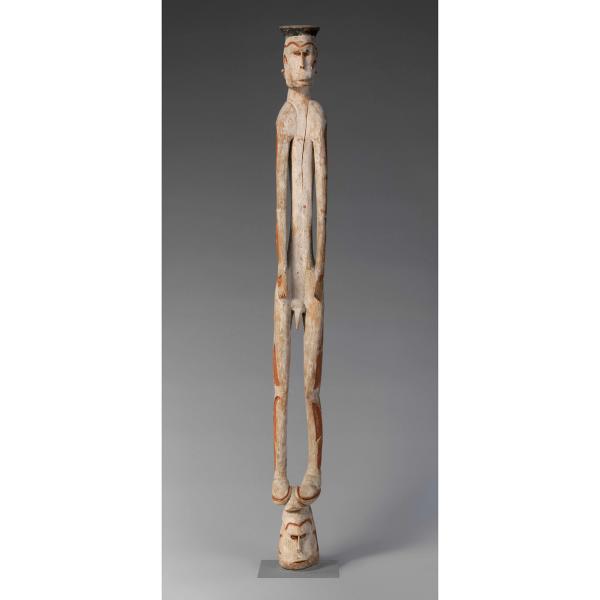Male ancestor figure
Almost all human images in Asmat art depict recent ancestors, whose names they bear. Freestanding ancestor figures such as this one were created in some areas for ceremonies celebrating the inauguration of a new men’s ceremonial house. During the rites, performers reenacted the origin of humanity, dancing with intentional awkwardness to simulate the movements of the first humans as they were gradually brought to life by Fumeripits's drumming.
Artwork Details
- Title: Male ancestor figure
- Artist: Ndojokor
- Date: ca. 1961
- Geography: Indonesia, Papua Province (Irian Jaya), Amanamkai village, Assuwe (As) River
- Culture: Asmat people
- Medium: Wood, paint
- Dimensions: H. 81 1/2 × W. 8 × D. 9 in. (207 × 20.3 × 22.9 cm)
- Classification: Wood-Sculpture
- Credit Line: The Michael C. Rockefeller Memorial Collection; Gift of Nelson A. Rockefeller and Mrs. Mary C. Rockefeller, 1965
- Object Number: 1978.412.1155
- Curatorial Department: The Michael C. Rockefeller Wing
Audio

1729. Asmat Ancestral Figures
Yustinus Sempah
YUSTINUS SEMPAH (English translation): I would like to tell the story of Fumeripitsj creating the first humans in Asmat.
KATERINA TEAIWA (NARRATOR): For the Asmat people of southwest New Guinea, ancestor figures like these relate to fundamental origin stories. The following is one version of an origin story, told by Yustinus Sempah from Er Village. He spoke to photojournalist Joshua Irwandi in 2022.
YUSTINUS SEMPAH (English translation): In the beginning, Fumeripitsj plans to build the first men’s ceremonial house, called jeu.
He starts to gather materials.
He creates the foundation by driving a pole into the ground. The moment he drives the wood into the ground, immediately the jeu is erected.
After that, Fumeripitsj begins to think about creating humans out of wood.
He gathers materials to create statues, male and female statues alike.
And it begins. He starts to carve statue after statue.
Fumeripitsj then feels he is lacking the tools to give statues life to become human beings.
He needs to make a tifa, a drum.
He peels the skin off a monitor lizard. He takes blood from his own calves and uses it to bind the lizard skin to the wood drum. The tifa is made.
For the next step, Fumeripitsj gathers leaves. He rubs them against the statues, so the statues can come to life.
Fumeripitsj takes the tifa, starts swinging his arm slowly, and mutters words.
Before he pounds the tifa, he says, “O statues, my children. After I pound the tifa, you have to move, as freely as you can.”
KATERINA TEAIWA: Look at the way the figures’ elbows and knees are joined together. On the smallest figure in the middle, you’ll see a small pad between his hands where the wood is still joined. These details in the carving refer to this stage in the story, before the carvings come fully to life.
YUSTINUS SEMPAH (English translation): Slowly, all the statues start moving according to the rhythm of the tifa. As the pounding gets stronger, so do the statues.
They all stand, and finally they cheer. They rejoice and dance.
The wooden statues have turned into the first humans, male and female, whose numbers fill the large house, or jeu.
###
Woodcarving audio: Joshua Irwandi, with the support of the National Geographic Society.
More Artwork
Research Resources
The Met provides unparalleled resources for research and welcomes an international community of students and scholars. The Met's Open Access API is where creators and researchers can connect to the The Met collection. Open Access data and public domain images are available for unrestricted commercial and noncommercial use without permission or fee.
To request images under copyright and other restrictions, please use this Image Request form.
Feedback
We continue to research and examine historical and cultural context for objects in The Met collection. If you have comments or questions about this object record, please complete and submit this form. The Museum looks forward to receiving your comments.